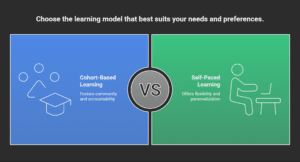Introduction to Learning Modalities: Understanding the Foundations of Modern Education
In today’s dynamic education and corporate training environments, comprehending various learning modalities is crucial for designing effective and engaging learning experiences. Among these, two primary approaches—cohort-based learning and self-paced learning—serve different needs and preferences.
They influence how learners interact with content, collaborate with peers, and achieve their goals. Recognizing the nuances of each modality helps educators and organizations tailor training programs that maximize engagement and knowledge retention.
Defining Cohort-Based and Self-Paced Learning: Key Concepts Explained
Cohort-based learning involves structured programs where learners move through the curriculum simultaneously within a specific group or “cohort.” These courses typically follow a fixed schedule, with live sessions, group discussions, and shared assignments, fostering a sense of community and accountability.
In contrast, self-paced learning allows individuals to access and progress through content independently. Learners can choose when to start and finish modules, accommodating personal schedules. This asynchronous approach offers maximum flexibility, making it ideal for those balancing multiple commitments.
Core Characteristics and Key Differences Between Cohort-Based and Self-Paced Learning
| Aspect | Cohort-Based Learning | Self-Paced Learning |
|---|---|---|
| Pace | Synchronized, fixed schedule | Flexible, learner-driven |
| Interaction | Live discussions, group work | Primarily individual engagement |
| Scheduling | Set start and end dates | Any time, no fixed deadlines |
| Community Building | Strong, collaborative environment | Limited, individual focus |
| Feedback & Support | Real-time feedback from instructors | Asynchronous support through forums |
Understanding these core differences helps in selecting the modalities that best align with learner needs, organizational goals, and resource availability. Combining elements of both can often produce a more versatile and effective learning environment.
Advantages and Disadvantages of Cohort-Based and Self-Paced Learning Models
Cohort-Based Learning: Benefits and Challenges
Benefits for Learners and Educators: Cohort-based learning fosters community, peer engagement, and accountability. This collaborative environment enhances motivation and retention, as students grow and learn together. According to Harvard Business Review, such models promote networking, improve learning outcomes, and enable instructors to adapt their teaching based on real-time feedback.
Challenges: The fixed schedule can be restrictive, posing difficulties for learners with busy lives. It requires significant resources for coordination, especially with large cohorts. Scheduling conflicts might lead to attrition, and some learners may find strict timelines stressful.
Self-Paced Learning: Advantages and Drawbacks
Benefits for Learners and Educators: Self-paced learning offers maximum flexibility, empowering learners to study at their convenience. It supports personalized learning paths, where individuals can go through materials as quickly or slowly as they prefer. This model reduces instructor workload temporarily and allows learners to revisit content for better retention.
Challenges: Motivation can wane without external deadlines or peer interaction. Learners may procrastinate or lose focus, and the absence of immediate instructor support might hinder clarification of complex topics. Ensuring accountability requires additional mechanisms.

How to Choose the Ideal Learning Mode for Your Organization or Personal Goals
Assessing Learners’ Goals and Objectives
Begin by clearly defining what learners aim to achieve. For rapid skill acquisition or practical training, cohort-based or blended approaches work well. For theoretical depth or regulatory compliance, self-paced modules can be more suitable. Measurable objectives guide the choice of the most effective modality.
Understanding the Audience Characteristics
Consider age, technological proficiency, location, and learning preferences. Tech-savvy professionals might prefer flexible digital courses, while beginners or those needing hands-on guidance may benefit from instructor-led sessions. Tailoring methods to audience traits enhances engagement and success.
Evaluating Resources and Infrastructure
Assess technological capacity, budget, and human resources. Organizations with robust IT infrastructure can implement advanced e-learning platforms and hybrid models. Those with limited technology might opt for blended learning involving face-to-face sessions complemented by online materials.
Implementing Hybrid and Blended Solutions
Combining modalities—such as online self-paced modules with periodic in-person sessions—offers flexibility and depth. Hybrid models cater to diverse preferences and can improve retention. Effective integration requires planning to ensure seamless transition between different methods.
Tips for an Effective Learning Strategy
- Perform thorough needs assessments aligned with goals.
- Identify learner profiles to customize delivery methods.
- Evaluate technological infrastructure before choosing digital options.
- Use pilot programs to test and refine hybrid approaches.
- Remain adaptable, combining models to meet evolving needs.
Supporting Both Learning Models with Paradiso LMS
Enabling Cohort-Based Learning through Live Sessions and Interactive Features
Paradiso LMS provides integrated tools for live webinars, virtual classrooms, and instructor-led sessions. These features facilitate real-time interaction, fostering engagement and community building among participants. Discussion forums further encourage peer-to-peer collaboration outside scheduled sessions, enhancing social learning and knowledge sharing.
Enhancing Self-Paced Learning with Content Drip and Progress Monitoring
The platform’s content drip functionality allows scheduled release of modules, maintaining learner motivation and managing content overload. Progress tracking dashboards deliver real-time insights into learner achievements, enabling both learners and administrators to identify areas needing support and make data-driven adjustments.
Centralized Management for Cohesive Training Delivery
Paradiso LMS offers comprehensive analytics, reporting tools, and administrative controls. These enable efficient management of enrollments, assessments, and content organization across both cohorts and independent learners. The result is a seamless, high-quality learning experience tailored to organizational needs.
🚀 Ready to See Paradiso LMS in Action?
Let’s show you how Paradiso LMS can work for you.
Conclusion: Choosing the Right Learning Solution to Drive Success
Ultimately, selecting the appropriate learning model depends on your organization’s unique needs, resources, and learner profiles. Whether you favor traditional classroom settings, modern blended approaches, or fully digital solutions, understanding the strengths and limitations of each can maximize training effectiveness.
Leverage platforms like Paradiso LMS to support versatile learning strategies. With robust tools for live sessions, content management, and analytics, Paradiso empowers organizations to deliver engaging, scalable, and outcome-oriented training programs.
Now is the moment to evaluate your training needs and choose a solution that drives growth, enhances skills, and fosters lifelong learning. Start transforming your educational initiatives today with a reliable LMS partner like Paradiso!













